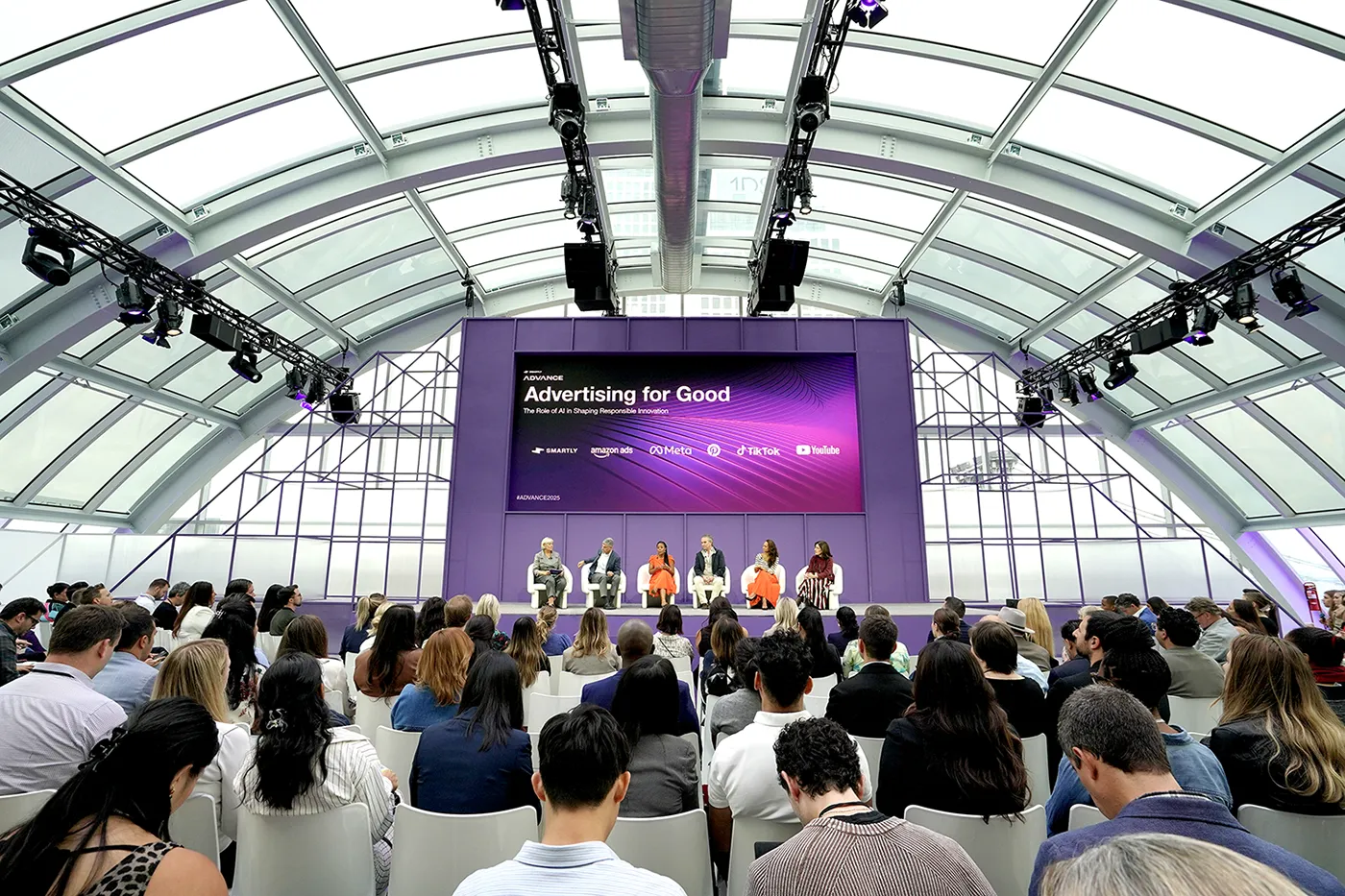
Advertising for Good: The Role of AI in Shaping Responsible Innovation
As AI transforms advertising, leaders from Amazon, Google, Meta, Pinterest, and TikTok came together at ADVANCE 2025 to explore how to balance performance with responsibility, driving personalization, trust, and real impact while navigating innovation, well-being, and ethics.
Laura Desmond, CEO of Smartly, was joined by:
- Judy Toland — Vice President, Global Audience Marketing, Meta
- Alan Moss — Vice President of Global Advertising Sales, Amazon
- Bill Watkins — Chief Revenue Officer, Pinterest
- Tara Walpert Levy — Vice President, Americas, YouTube/Google
- Khartoon Weiss — Global Head of Business Marketing, TikTok
AI as an Amplifier, Not a Replacement
The marketing leaders quickly aligned on one point: AI is most powerful when it extends what humans do best. Tara Walpert Levy explained that the goal isn’t to automate creativity out of the process, but to give teams the time and tools to focus on storytelling, empathy, and connection.
As Alan Moss put it, “Our philosophy is that AI is to amplify and extend the creativity of humans”.
From editing to translation to large-scale personalization, AI is removing friction that has historically slowed creative development. This shift allows marketers to move beyond production bottlenecks and dedicate more resources to ideas and insights, the elements that make campaigns resonate on a human level.
Scale and Efficiency Meet Creative Agility
For decades, advertising followed a playbook built around a handful of polished creative assets. Today, that model no longer works. Audiences expect variety, cultural relevance, and personalization in real time, and AI is the only way to meet that demand at scale.
Alan Moss illustrated how AI enables brands to break free from tough trade-offs. In the past, advertisers with broad product catalogs had to decide which handful of items to spotlight in campaigns. Now, AI can generate thousands of unique creative variations across markets and audiences, ensuring that every product and message has its moment.
Moderator Laura Desmond underscored the magnitude of this change: “It’s no longer 100 variations challenging convention. It’s 100,000. This is the AI era”.
Instead of relying on a single big creative idea, brands can now test, learn, and adapt faster than ever before, a level of agility that is becoming a baseline expectation.
Trust and Humanity as Differentiators
While AI delivers efficiency, the panelists emphasized that humanity will determine who truly wins. Bill Watkins noted that platforms have a responsibility to design for user safety, building trust into their systems at every layer.
Consumers are demanding both personalization and transparency. They want ads that feel relevant without feeling invasive, and platforms that put honesty and control at the forefront. That requires not just new tools, but new governance frameworks, creative guardrails, and a commitment to cultural sensitivity.
Khartoon Weiss added that authenticity is what keeps communities thriving. Brands that show up in real and culturally aware ways will be embraced, those that don’t will quickly be ignored.
From Experimentation to Commitment
The conversation made clear that the industry is past the experimentation phase. AI is no longer a novelty; it’s the foundation of how campaigns will be built, optimized, and measured.
Laura Desmond issued a call to action: “We must disrupt ourselves before technology does it to us. Our industry has never been about the tool. It’s about how we use it and the impact and the feeling that people have on the other side”.
Commitment means more than adopting new software. It means rethinking team structures, workflows, and measurement systems to fully integrate AI. It means equipping creative and media teams with shared data, shared insights, and shared responsibility for results. It means moving from campaign planning cycles measured in months to creative decisions made in real time.
Advertising for Good: Driving Business and Society Forward
Throughout the discussion, the panelists repeatedly emphasized that advertising has a responsibility that extends beyond performance metrics. When deployed thoughtfully, AI can help brands contribute to societal good: advancing mental health awareness, expanding representation, and supporting inclusive storytelling.
Judy Toland highlighted the power of campaigns that showcase underrepresented voices and promote safe environments for dialogue. Khartoon Weiss described how community-driven storytelling on TikTok continues to spark meaningful cultural change, from grassroots movements to mainstream conversations.
The consensus was clear: advertising is at its best when it fuels business growth and shapes culture in positive ways. AI is the enabler, but humanity is the differentiator.
The Bottom Line
The Advertising for Good panel made one message clear: by 2028, nearly all advertising will be powered by AI, but the brands that stand apart will be those that put people first.
As Laura shared in her keynote, “Our industry has never been about the tool. It’s about how we use it and the impact and the feeling that people have on the other side.”
Efficiency may drive reach. Empathy will drive trust.
ADVANCE 2025 is only the beginning. The revolutionary ideas shared in New York are already reshaping marketing, and if you weren’t in the room, these recaps are your next best bet. More takeaways will be rolling out in the coming weeks. Stay tuned, to make sure you can stay ahead.
Join the conversation with #ADVANCE2025 on LinkedIn.
Advertising for Good: The Role of AI in Shaping Responsible Innovation

As AI transforms advertising, leaders from Amazon, Google, Meta, Pinterest, and TikTok came together at ADVANCE 2025 to explore how to balance performance with responsibility, driving personalization, trust, and real impact while navigating innovation, well-being, and ethics.
Laura Desmond, CEO of Smartly, was joined by:
- Judy Toland — Vice President, Global Audience Marketing, Meta
- Alan Moss — Vice President of Global Advertising Sales, Amazon
- Bill Watkins — Chief Revenue Officer, Pinterest
- Tara Walpert Levy — Vice President, Americas, YouTube/Google
- Khartoon Weiss — Global Head of Business Marketing, TikTok
AI as an Amplifier, Not a Replacement
The marketing leaders quickly aligned on one point: AI is most powerful when it extends what humans do best. Tara Walpert Levy explained that the goal isn’t to automate creativity out of the process, but to give teams the time and tools to focus on storytelling, empathy, and connection.
As Alan Moss put it, “Our philosophy is that AI is to amplify and extend the creativity of humans”.
From editing to translation to large-scale personalization, AI is removing friction that has historically slowed creative development. This shift allows marketers to move beyond production bottlenecks and dedicate more resources to ideas and insights, the elements that make campaigns resonate on a human level.
Scale and Efficiency Meet Creative Agility
For decades, advertising followed a playbook built around a handful of polished creative assets. Today, that model no longer works. Audiences expect variety, cultural relevance, and personalization in real time, and AI is the only way to meet that demand at scale.
Alan Moss illustrated how AI enables brands to break free from tough trade-offs. In the past, advertisers with broad product catalogs had to decide which handful of items to spotlight in campaigns. Now, AI can generate thousands of unique creative variations across markets and audiences, ensuring that every product and message has its moment.
Moderator Laura Desmond underscored the magnitude of this change: “It’s no longer 100 variations challenging convention. It’s 100,000. This is the AI era”.
Instead of relying on a single big creative idea, brands can now test, learn, and adapt faster than ever before, a level of agility that is becoming a baseline expectation.
Trust and Humanity as Differentiators
While AI delivers efficiency, the panelists emphasized that humanity will determine who truly wins. Bill Watkins noted that platforms have a responsibility to design for user safety, building trust into their systems at every layer.
Consumers are demanding both personalization and transparency. They want ads that feel relevant without feeling invasive, and platforms that put honesty and control at the forefront. That requires not just new tools, but new governance frameworks, creative guardrails, and a commitment to cultural sensitivity.
Khartoon Weiss added that authenticity is what keeps communities thriving. Brands that show up in real and culturally aware ways will be embraced, those that don’t will quickly be ignored.
From Experimentation to Commitment
The conversation made clear that the industry is past the experimentation phase. AI is no longer a novelty; it’s the foundation of how campaigns will be built, optimized, and measured.
Laura Desmond issued a call to action: “We must disrupt ourselves before technology does it to us. Our industry has never been about the tool. It’s about how we use it and the impact and the feeling that people have on the other side”.
Commitment means more than adopting new software. It means rethinking team structures, workflows, and measurement systems to fully integrate AI. It means equipping creative and media teams with shared data, shared insights, and shared responsibility for results. It means moving from campaign planning cycles measured in months to creative decisions made in real time.
Advertising for Good: Driving Business and Society Forward
Throughout the discussion, the panelists repeatedly emphasized that advertising has a responsibility that extends beyond performance metrics. When deployed thoughtfully, AI can help brands contribute to societal good: advancing mental health awareness, expanding representation, and supporting inclusive storytelling.
Judy Toland highlighted the power of campaigns that showcase underrepresented voices and promote safe environments for dialogue. Khartoon Weiss described how community-driven storytelling on TikTok continues to spark meaningful cultural change, from grassroots movements to mainstream conversations.
The consensus was clear: advertising is at its best when it fuels business growth and shapes culture in positive ways. AI is the enabler, but humanity is the differentiator.
The Bottom Line
The Advertising for Good panel made one message clear: by 2028, nearly all advertising will be powered by AI, but the brands that stand apart will be those that put people first.
As Laura shared in her keynote, “Our industry has never been about the tool. It’s about how we use it and the impact and the feeling that people have on the other side.”
Efficiency may drive reach. Empathy will drive trust.
ADVANCE 2025 is only the beginning. The revolutionary ideas shared in New York are already reshaping marketing, and if you weren’t in the room, these recaps are your next best bet. More takeaways will be rolling out in the coming weeks. Stay tuned, to make sure you can stay ahead.
Join the conversation with #ADVANCE2025 on LinkedIn.
Honestly, we'd rather just show you.
Chat with our team to see how Smartly transforms the fragmented advertising ecosystem into something suspiciously manageable.






.webp)

%201%20(1)%201%201.avif)

